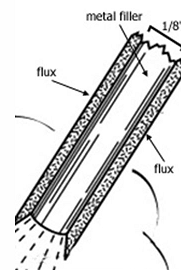1. Which one of the following is not a function of a riser?
(a) to help the flow of metal towards the mould cavity
(b) to provide an escape to hot gases
(c) to feed the metal to the casting as it shrinks during solidification
(d) to help streamline the flow of metal into a runner
2. The required cutting speed in metre/min in machining a workpiece with a diameter of 100 mm and a speed of 500 rpm will be
(a) 628
(b) 262
(c) 157
(d) 37.7
3. Quick return mechanism is used in
(a) slotter
(b) broach
(c) milling
(d) lathe
4. The collapsible tooth-paste tubes are produced by
(a) impact extrusion
(b) direct extrusion
(c) indirect extrusion
(d) tube extrusion
5. Aluminium oxide abrasive is used for grinding
(a) grey cast iron
(b) high-speed steels
(c) cemented carbides
(d) ceramic materials
6. Which of the following materials is used as the dielectric fluid in electro-discharge machining?
(a) Kerosene
(b) NaCl
(c) NaOH
(d) NaNO₃
7. Wax pattern is used in
(a) die casting
(b) shell moulding
(c) investment casting
(d) plaster moulds
8. The material used for coating the electrode is called
(a) flux
(b) slag
(c) deoxidiser
(d) binder
9. Casting is a preferred process for parts having
(a) a few details
(b) many details
(c) non-symmetrical shape
(d) none of the above
10. Size of the shaper is specified by
(a) size of table
(b) H.P. of motor
(c) the ratio of forward to return stroke
(d) length of stroke
Answers with Explanations
- (d) Hollow sections such as cups, toothpaste containers are made by impact extrusion. It is a variation of indirect extrusion. Hollow sections such as cups, toothpaste containers are made by impact extrusion. It is a variation of indirect extrusion.
- (c) Cutting speed = πDn/1000, D in mm, n in rpm
- (a) This quick return mechanism is mostly used in shaping machines, slotting machines and rotary internal combustion engines.
- (a) Hollow sections such as cups, toothpaste containers are made by impact extrusion. It is a variation of indirect extrusion.
- (d) Aluminium oxide or zirconia alumina is used for grinding steels and steel alloys. For grinding cast iron, non-ferrous metals and non-metallic materials, select a silicon carbide abrasive.
- (a) Electrical Discharge Machining (EDM) is a manufacturing process whereby a desired shape is obtained by using electrical discharges (sparks). In EDM a fluid is used to act as a dielectric and to help carry away debris. Quite often kerosene-based oil is used as dielectric in EDM.
- (c) For the preparation of the pattern for every casting to be made, molten wax is used as the pattern material, which is injected under the pressure of about 2.5 MPa into a metallic die, which has the cavity of the casting to be made. After the solidification of wax, it would produce the pattern.
- (a) A flux coating is a layer of a chemical that acts as a cleaning agent, a purifying agent, or a flowing agent. It protects the weld pool and solid metal from atmospheric contamination and helps in removing impurities from the weld pool.
- (b) Casting is is a process in which liquefied material, such as molten metal, is poured into the cavity of a specially designed mould and allowed to harden. Casting is typically used to create intricate solid shapes of having many details, and cast products are found in a wide range of applications, including automotive components, aerospace parts, electronics, mechanical devices, and construction supplies.
- (d) The size of the shaper is specified by the maximum length of stroke or cut it makes. The maximum stroke length of the shaper is 900 mm.
---
The study material for AMIE/B Tech/Junior Engineer exams is available at https://amiestudycircle.com


Comments